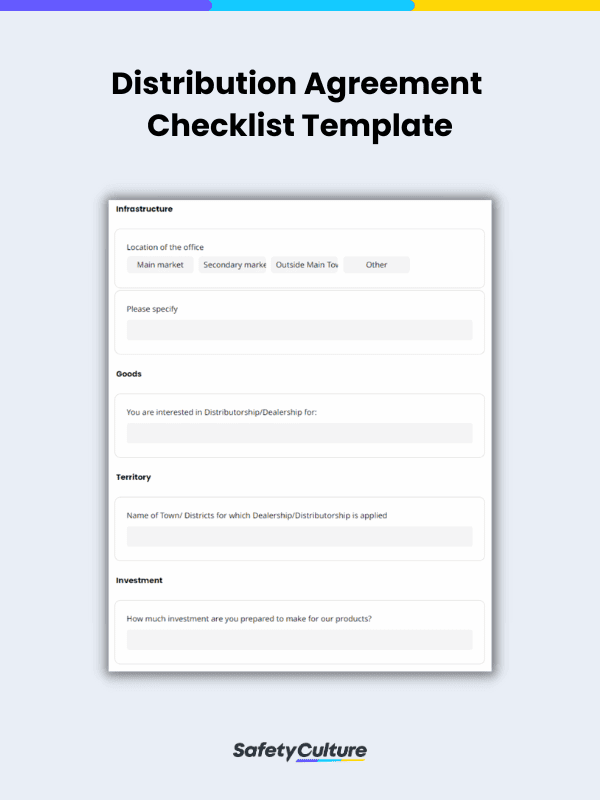What is a Distribution Agreement?
A distribution agreement is a legal arrangement between suppliers and goods distributors concerning product deliverables, inspection requirements, and delivery risks. It is an official document that can be used as a legal reference for contractual issues concerning financial costs and product distribution errors.
Importance of Distribution Agreement
A distribution agreement is a mutually accessible document that makes each other’s responsibilities clear to both the supplier and the distributor. It can act as a waiver, which makes it easier for both parties to complete their duties efficiently while avoiding misunderstandings, disputes, and process errors. A distribution agreement also helps businesses:
- secure availability of products;
- identify exclusivity of supplies;
- increase the distribution potential of products; and
- avoid frauds or other forms contract breach.
Key Elements of a Distribution Agreement Checklist
To make contractual obligations clear and ensure a smooth transition from supply to distribution, distribution agreements must contain the following key elements:
Purpose
A distribution agreement must clearly define its purpose which includes the appointment, acceptance, and scope of the agreement between the supplier and the distributor. The distribution agreement also states whether product distribution is exclusive or non-exclusive within a defined territory.
Agreement clauses
Terms and conditions should be stated clearly by agreement clauses for the reference of sellers and distributors. Agreement clauses enumerate each party’s responsibility and obligation for easy accountability in case issues regarding missed deliveries, inappropriate re-branding of products, or other contract breaches are committed. The agreement clauses are the declaration of negotiable terms and liabilities agreed upon by both parties.
Verification
Verification is the most important element of a distribution agreement. All agreements between the supplier and the distributor should be documented and confirmed—validated by both sides with official signatures. Doing so legally enforces all the clauses under the distribution agreement which protects both parties from a contractual breach.
Components of a Good Distribution Agreement Template
A distribution agreement template is used across the manufacturing industry to legally record the agreement between suppliers and distributors. It is a flexible document that adapts to multiple factors that govern a supplier-distributor arrangement. Here are the components of a good distribution agreement template:
- Terms and conditions of supply – This defines the structure and limitations of distribution in an agreed-upon territory and includes the following information:
- The contract’s effective duration.
- The geographical coverage of distribution, including regional and/or international terms.
- Products to be supplied including dates and time-frames.
- Minimum purchase needed.
- Payment terms based on the agreed-upon negotiation.
- The obligations of subagents, sub-distributors, or sub-representatives if applicable.
- Marketing rights – This defines the accepted marketing strategies and contract terms for selling the products and should include the following information:
- Product prices and shipment fees.
- Advertisement strategies.
- Percentage of commission from commercial sales.
- Bundle sale terms and limitations.
- Distributor responsibilities for product resale.
Guidelines covering branding.
- Trademark licensing – This states whether product re-branding is permitted or not and should also include the following:
- Allowed changes in packaging if applicable or if original packaging must be maintained.
- Validity, ownership, or enforceability of any of the trademarks of the company.
- A reminder that changes in products must not damage the reputation and branding of the distributing company.
- Performance – This states the right to monitor sales, inventory and marketing implementation of a product and should include the following:
- Specific warranties and reports needed for product recall or return of stocks.
- Minimum sale requirements depending on the territory.
- Training responsibilities and turnover processes and protocols.
- Contract Termination – These are the circumstances under which the contract may be terminated and should include the following:
- Effective duration of the agreement.
- Offenses that may result in contract termination from both the supplier and distributor side.
- Obligations of the vendor(s) or supplier(s) after the termination of the contract.
- Optional way to terminate or renew the contract.



